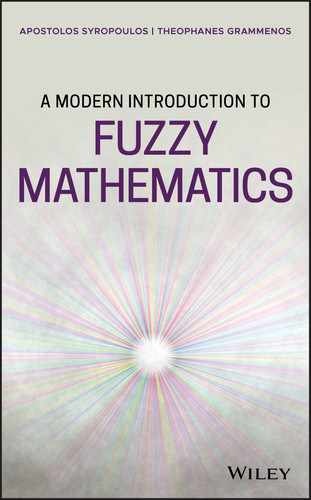Provides readers with the foundations of fuzzy mathematics as well as more advanced topics A Modern Introduction to Fuzzy Mathematics provides a concise presentation of fuzzy mathematics., moving from proofs of important results to more advanced topics, like fuzzy algebras, fuzzy graph theory, and fuzzy topologies. The authors take the reader through the development of the field of fuzzy mathematics, starting with the publication in 1965 of Lotfi Asker Zadeh's seminal paper, Fuzzy Sets. The book begins with the basics of fuzzy mathematics before moving on to more complex topics, including: Perfect for advanced undergraduate students, graduate students, and researchers with an interest in the field of fuzzy mathematics, A Modern Introduction to Fuzzy Mathematics walks through both foundational concepts and cutting-edge, new mathematics in the field.
Table of Contents
- Cover
- Preface
- Acknowledgments
- 1 Introduction
- 2 Fuzzy Sets and Their Operations
- 2.1 Algebras of Truth Values
- 2.2 Zadeh's Fuzzy Sets
- 2.3 ‐Cuts of Fuzzy Sets
- 2.4 Interval-valued and Type 2 Fuzzy Sets
- 2.5 Triangular Norms and Conorms
- 2.6 ‐fuzzy Sets
- 2.7 “Intuitionistic” Fuzzy Sets and Their Extensions
- 2.8 The Extension Principle
- 2.9* Boolean‐Valued Sets
- 2.10* Axiomatic Fuzzy Set Theory
- Exercises
- Notes
- 3 Fuzzy Numbers and Their Arithmetic
- 4 Fuzzy Relations
- 4.1 Crisp Relations
- 4.2 Fuzzy Relations
- 4.3 Cartesian Product, Projections, and Cylindrical Extension
- 4.4 New Fuzzy Relations from Old Ones
- 4.5 Fuzzy Binary Relations on a Set
- 4.6 Fuzzy Orders
- 4.7 Elements of Fuzzy Graph Theory
- 4.8 Fuzzy Category Theory
- 4.9 Fuzzy Vectors5
- 4.10 Applications
- Exercises
- Notes
- 5 Possibility Theory
- 6 Fuzzy Statistics
- 7 Fuzzy Logics
- 7.1 Mathematical Logic
- 7.2 Many‐Valued Logics
- 7.3 On Fuzzy Logics
- 7.4 Hájek's Basic Many‐Valued Logic
- 7.5 Łukasiewicz Fuzzy Logic
- 7.6 Product Fuzzy Logic
- 7.7 Gödel Fuzzy Logic
- 7.8 First‐Order Fuzzy Logics
- 7.9 Fuzzy Quantifiers
- 7.10 Approximate Reasoning
- 7.11 Application: Fuzzy Expert Systems
- 7.12 A Logic of Vagueness
- Exercises
- Notes
- 8 Fuzzy Computation
- 9 Fuzzy Abstract Algebra
- 10 Fuzzy Topology
- 10.1 Metric and Topological Spaces1
- 10.2 Fuzzy Metric Spaces
- 10.3 Fuzzy Topological Spaces6
- 10.4 Fuzzy Product Spaces
- 10.5 Fuzzy Separation
- 10.6 Fuzzy Nets
- 10.7 Fuzzy Compactness
- 10.8 Fuzzy Connectedness
- 10.9 Smooth Fuzzy Topological Spaces
- 10.10 Fuzzy Banach and Fuzzy Hilbert Spaces
- 10.11 Fuzzy Topological Systems
- Exercises
- Notes
- 11 Fuzzy Geometry
- 12 Fuzzy Calculus
- A Fuzzy Approximation
- B Chaos and Vagueness
- Works Cited
- Subject Index
- Author Index
- End User License Agreement
